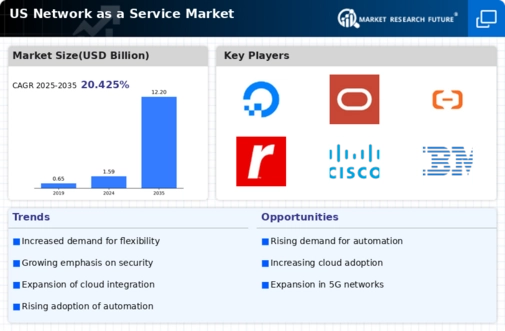Cost Efficiency and Budget Optimization
Cost efficiency remains a pivotal driver in the network as-a-service market. Organizations are increasingly recognizing the financial benefits of adopting a network as-a-service model, which allows them to reduce capital expenditures associated with traditional networking infrastructure. By leveraging subscription-based services, companies can optimize their budgets and allocate resources more effectively. Recent analyses indicate that businesses can save up to 30% on networking costs by transitioning to a network as-a-service model. This financial incentive is particularly appealing to small and medium-sized enterprises (SMEs) that may lack the capital for extensive infrastructure investments. As a result, the network as-a-service market is likely to see continued growth as organizations seek to enhance their cost management strategies.
Regulatory Compliance and Data Governance
It is increasingly influenced by the need for regulatory compliance and data governance. Organizations are facing mounting pressure to adhere to various regulations, such as the General Data Protection Regulation (GDPR) and the Health Insurance Portability and Accountability Act (HIPAA). This regulatory landscape necessitates that businesses implement secure and compliant networking solutions. As a result, service providers are enhancing their offerings to ensure that they meet compliance standards, which is becoming a key differentiator in the network as-a-service market. Companies that prioritize compliance are likely to gain a competitive edge, as they can assure clients of their commitment to data security and governance, thereby fostering trust and reliability.
Growing Demand for Flexible Networking Solutions
There is a notable surge in demand for flexible networking solutions. Organizations are increasingly seeking to adapt their network infrastructure to meet dynamic business needs. This shift is driven by the necessity for scalability and agility in operations. According to recent data, the market is projected to grow at a compound annual growth rate (CAGR) of approximately 25% over the next five years. This growth reflects a broader trend where businesses prioritize flexibility in their networking capabilities, allowing them to respond swiftly to market changes. As companies transition to more digital operations, the network as-a-service market is positioned to play a crucial role in enabling this transformation, providing tailored solutions that align with specific organizational requirements.
Integration of Advanced Analytics and AI Technologies
The integration of advanced analytics and artificial intelligence (AI) technologies is emerging as a transformative driver in the network as-a-service market. Organizations are increasingly leveraging these technologies to gain insights into network performance and optimize operations. By utilizing AI-driven analytics, businesses can proactively identify potential issues, enhance decision-making processes, and improve overall network efficiency. This trend is indicative of a broader movement towards data-driven strategies in networking. As companies seek to harness the power of AI, the network as-a-service market is likely to witness significant advancements, with service providers offering innovative solutions that incorporate these technologies to meet evolving customer demands.
Increased Focus on Network Performance and Reliability
In the current landscape, the emphasis on network performance and reliability is becoming increasingly pronounced within the network as-a-service market. Organizations are demanding high-performance networks that can support critical applications and services without interruption. This demand is underscored by the need for seamless connectivity and minimal downtime, which are essential for maintaining operational efficiency. Data suggests that businesses are willing to invest significantly in solutions that enhance network reliability, with some companies reporting up to a 40% increase in productivity due to improved network performance. Consequently, service providers in the network as-a-service market are compelled to innovate and deliver robust solutions that meet these heightened expectations.























Leave a Comment